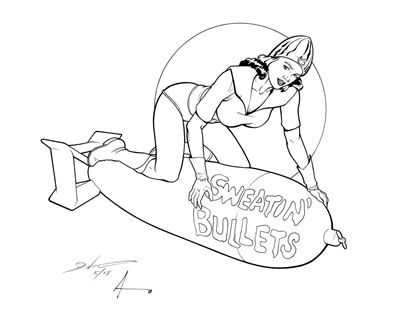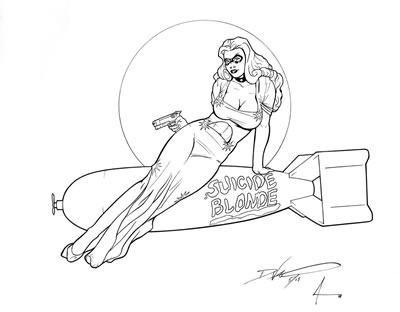Bombshells! part B
I'll wait.
Waiting...
Up to speed now?
Righteous.
Anyway, you now grok the basic Bombshells! concept: Superheroines from the 1940s, featured in pinups modeled after World War II-era bomber nose art. Mighty doggoned inventive, yes?
So let's check out a couple more. Like the first two Bombshells!, today's drawings showcase the sleek stylings of penciler Dan Veesenmeyer and the solid embellishments of inker Bob Almond.
First, allow me to introduce you to Bulletgirl.

Although Susan Kent (hmm... where have I heard that surname before?) was featured in the stories about her paramour, Jim Barr — a.k.a. Bulletman — from the beginning (Nickel Comics #1, May 1940), it wasn't until almost a year after their debut that Susan became Bulletgirl (Master Comics #13, April 1941). The projectile pair continued their war against evil throughout the 1940s, eventually fading from the scene — along with most other costumed comic book characters — at the end of that decade.
Bulletgirl, while not widely remembered today except by comics historians and hardcore aficionados, proved in many respects a pioneer of things to come. She was the first superheroine to fight alongside her similarly uniformed husband (Susan and Jim having tied the proverbial knot along the way), foreshadowing such familiar characters as the Invisible Woman of the Fantastic Four. Bulletgirl also blazed the nomenclatural trail for the myriad Batgirls, Supergirls, She-Hulks, and Spider-Women who followed.
In addition, Bulletgirl was one of the few superpowered heroines to appear regularly — as something other than a damsel in distress — on comic book covers during her Golden Age heyday. Many of the early costumed females in comics who became popular enough to make cover appearances (i.e., the original Black Cat and the Blonde Phantom) lacked any superhuman abilities.
Speaking of the Blonde Phantom, she's now a Bombshell! too.

Unlike Bulletgirl and her ilk, the Blonde Phantom needed no namesake masculine counterpart on whose coattails she could travel. She was not only skilled enough to operate solo, but also fetching enough to sell comics with her own code name in the title. Following her premiere in All-Select Comics #11 (Fall 1946), the Blonde Phantom took over the masthead with the very next issue, titled Blonde Phantom Comics #12. She headlined the book until its cancellation in 1949.
Also unlike Bulletgirl, the Blonde Phantom — one of the few characters in comics history to make her hair color a selling point (Red Sonja is the only other I can think of, off the top of my head) — had no superscientific helmet to endow her with paranormal might. She had to make do with dispatching foes the old-fashioned way — with fashion, finesse, and a .45.
Like Ginger Rogers opposite Fred Astaire, the Blonde Phantom did everything that Batman or the Spirit could do — only she did it all in a floor-length evening gown (albeit with a thigh-high slit for... ah... freedom of movement) and stiletto pumps.
Did I mention that the Blonde Phantom was the first significant superheroine created by the legendary Stan Lee, a good 15 years before the dawn of Marvel Age of Comics?
And that's your Comic Art Friday.









0 insisted on sticking two cents in:
Post a Comment
<< Home